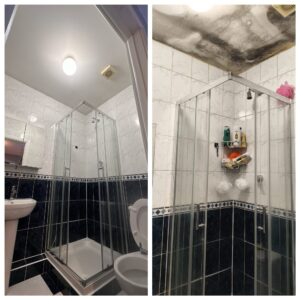How to Get Rid of Mould on Ceiling: A Complete Guide
Mould on the ceiling is a common problem in many homes, and it can be both unsightly and harmful to your health. If left unchecked, it can spread quickly, causing damage to the ceiling and potentially worsening air quality. Understanding the causes of ceiling mould is the first step in getting rid of it and preventing it from coming back.
Understanding the Causes of Ceiling Mould
Mould on ceilings typically grows due to excess moisture and poor ventilation. Common triggers include condensation from steamy bathrooms or kitchens, roof leaks, and inadequate airflow in closed spaces like basements or attics. Here are some of the most common causes of ceiling mould:
Excess Moisture: Areas that retain moisture, such as bathrooms and kitchens, are prime candidates for mould growth. When moisture accumulates on the ceiling, it creates the perfect environment for mould spores to thrive.
Poor Ventilation: Without proper airflow, humid air tends to settle on the ceiling, especially in rooms that generate a lot of moisture, like bathrooms or kitchens. Poor ventilation allows that moisture to stay trapped, encouraging mould growth.
Roof Leaks: A leaking roof can allow water to seep into your ceiling, providing a continuous source of moisture for mould to grow. The water damage often goes unnoticed until mould appears on the ceiling.
Hidden Leaks: Sometimes, plumbing pipes running through ceilings or walls can leak unnoticed, causing moisture to build up. This can lead to mould growth in areas that may not be immediately visible.
How to Get Rid of Mould on Ceiling
Removing mould from your ceiling requires a strategic approach. You need to address both the mould itself and the moisture issue that caused it. Here are the key steps for effectively getting rid of mould on your ceiling:
1. Gather the Right Cleaning Supplies
Before you start cleaning, make sure you have the right supplies to safely remove the mould. You’ll need:
A cleaning solution (such as a mix of bleach and water, white vinegar, or specialised mould cleaner)
A scrub brush or sponge
Rubber gloves, a mask, and protective eyewear (to avoid inhaling mould spores)
A step ladder or sturdy stool
A bucket and clean cloths for wiping down surfaces
2. Clean the Mouldy Area
Once you have your supplies, follow these steps:
Ventilate the Area: Open windows and doors to allow fresh air to circulate, helping to reduce moisture levels.
Prepare the Cleaning Solution: If you’re using bleach, mix one part bleach with three parts water in a spray bottle. Alternatively, use a mixture of white vinegar and water (in equal parts) for a more eco-friendly solution.
Apply the Solution: Spray the mouldy area generously with your chosen cleaning solution. Let it sit for about 15-20 minutes to kill the mould spores.
Scrub the Ceiling: Using a scrub brush or sponge, gently scrub the affected area. Be sure to work carefully to avoid damaging the ceiling surface. For tough spots, you may need to repeat the process.
Wipe Clean: Once the mould is gone, wipe the ceiling with a clean, damp cloth to remove any remaining cleaning solution and debris.
3. Dry the Ceiling Thoroughly
After cleaning, it’s important to dry the ceiling completely to prevent further mould growth. You can use a fan or dehumidifier to help speed up the drying process. A dry ceiling is less likely to become a breeding ground for mould in the future.
4. Fix the Underlying Moisture Problem
If you don’t address the cause of the mould, it’s likely to return. Here’s how you can prevent future mould growth:
Improve Ventilation: Ensure that areas like bathrooms and kitchens have proper ventilation. Install exhaust fans or open windows during and after activities that produce moisture.
Repair Leaks: If you discover a roof leak or hidden pipe leak, fix it as soon as possible. Consider having a professional inspect your roof and plumbing if you suspect underlying issues.
Use a Dehumidifier: In areas like basements or attics where moisture tends to accumulate, a dehumidifier can help reduce humidity levels and prevent mould from taking hold.
5. Consider Using Mould-Resistant Paint
Once you’ve cleaned and dried the area, you might want to apply mould-resistant paint to the ceiling. This type of paint helps prevent mould growth by creating a barrier against moisture.
| Cause | Description | Risk Areas |
|---|---|---|
| Condensation | Humidity from showers, cooking, or drying clothes indoors. | Bathrooms, kitchens |
| Leaks | Roof damage, burst pipes, or faulty plumbing. | Attics, ceiling corners |
| Poor Ventilation | Lack of airflow traps moisture. | Closed rooms, basements |
Step-by-Step Mould Removal Methods
Natural vs. Chemical Solutions Comparison
| Method | Ingredients | Pros | Cons |
|---|---|---|---|
| Vinegar Solution | White vinegar + water | Eco-friendly, non-toxic | Slower for severe mould |
| Bleach Mix | Bleach + water | Quick results | Harsh fumes may damage paint |
| Baking Soda Paste | Baking soda + water | Scrubs stains gently | Requires multiple uses |
Preventing Ceiling Mould: Long-Term Strategies
| Prevention Tip | Action Required | Benefit |
|---|---|---|
| Improve Ventilation | Install exhaust fans or dehumidifiers | Reduces humidity by 40-50% |
| Fix Leaks Promptly | Inspect roofs/pipes quarterly | Prevents water buildup |
| Use Anti-Mould Paint | Apply mould-resistant primer | Blocks spore growth for 5+ years |
FAQs About Ceiling Mould
| Question | Answer |
|---|---|
| Is bleach safe for painted ceilings? | Test a small area first—bleach may discolour the paint. |
| Can I paint over mould? | No! Always clean mould before painting. |
| How long does vinegar take to kill mould? | 1 hour for small patches; repeat for stubborn growth. |
When to Call a Professional
- The mould covers over 10 square feet.
- Recurring mould despite cleaning.
- Suspected hidden leaks or structural damage.
Final Tips
For severe cases, pair cleaning with a HEPA air purifier to remove airborne spores. Bookmark this guide for quick reference!


